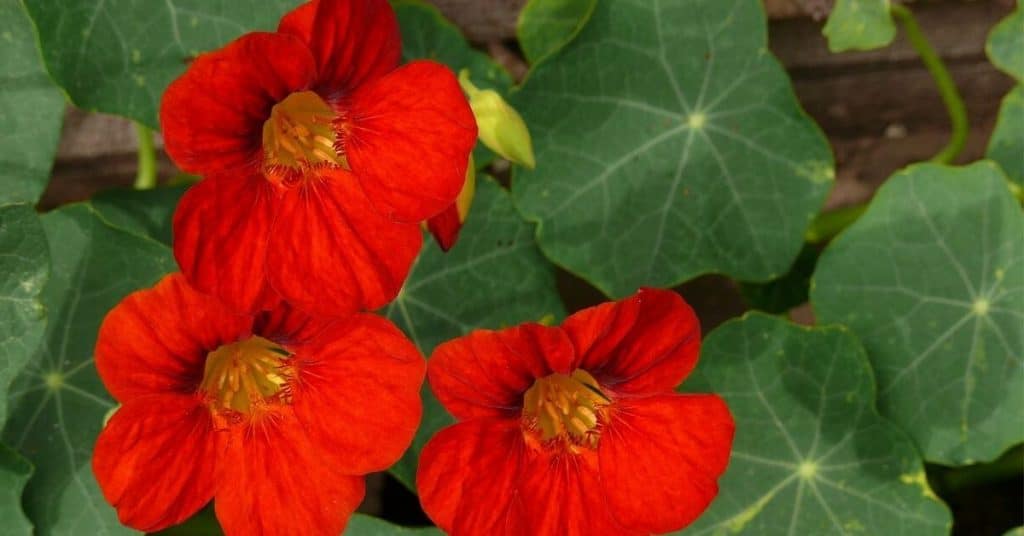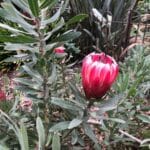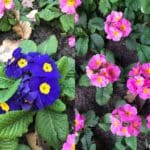Nasturtium is an easy-to-grow gorgeous outdoor flower which can be planted either in a pot or directly in the garden. It has an attractive fragrance, enjoys warm weather and is an annual plant which can make your blooming paradise even prettier!
In addition to that, it is an edible flower which is often used in unconventional gourmet recipes. This short guide can help you grow your own healthy and pretty nasturtiums and enjoy them!
Nasturtium Name and Meaning
Nasturtium is also known as Tropaeolum and nasturtian. The name of this flower has Latin origin and, directly translated, means ‘convulsed nose’.
This is believed to be associated with the facial gesture people make when they are eating the flowers and the variegated leaves of the plant, as it has a spicy, pepper-like taste, which is also similar to mustard (1).
The unique taste of the flower and its complete lack of poisonous ingredients have made it very popular in culinary and gourmet world. Nasturtium flowers and leaves are used as salad ingredients, beautiful garnish or as an addition to a tasty cocktail.
History, Evolution and Use
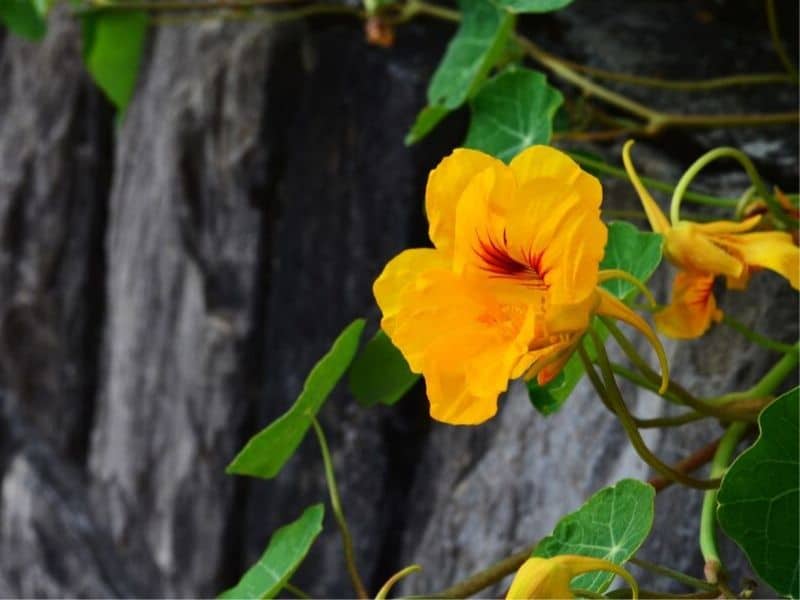
Initially, nasturtium is primarily found in South America (mainly in Bolivia and Columbia) and brought to Europe in 1864 by Spanish trading ships.
It has been perceived as a symbol of power, which is probably one of the reasons why it has quickly become one of the popular flowers of royal families and gardens. Nowadays, it is most commonly grown in Brazil, Columbia, and Peru (5).
During Victorian ages, nasturtium has been used as a way to express emotions and feelings through bouquets of different coloured flowers.
For example, red nasturtium flowers were interpreted as the feeling of passion and love and have been preferred by men who want to flirt with their chosen girl, while yellow nasturtium bouquets have been a symbol of happiness and joy and have been a popular gift between friends and family members (5).
In modern times, nasturtiums serve multiple purposes. They are widely used as garden flowers, as well as herbs for cooking and beverage-making. Additionally, nasturtiums have medicinal properties, addressing various health issues.
These versatile plants find their place in hanging baskets and gardens alike. Trailing nasturtiums, with their vibrant blooms, cascade gracefully from bushy plants.
Notably, their seed pods contain valuable compounds that contribute to their therapeutic effects. Nasturtiums are commonly used for treating pain, cramps, colds, coughs, throat aches, and respiratory issues. They also serve as a substitute for antibiotics and provide antioxidants for cleansing the human body from harmful bacteria.
It is also very rich in Vitamin C (approximately 130 mg per 100 g) which is also a reason to be used in a variety of food regimes, immune system boosting programs and popular diets (6).
Description, Varieties, and Blooming
Nasturtium flowers (Tropaeolum majus) offer a diverse array of varieties, each with its unique characteristics and colors.
- Varieties include the classic ‘Alaska’ with its variegated leaves and bright blooms in shades of orange, yellow, and red.
- ‘Empress of India’ boasts deep crimson flowers contrasting against its dark foliage.
- ‘Jewel Mix’ features a blend of vibrant colors, including shades of gold, orange, and mahogany.
- ‘Whirlybird’ produces semi-double flowers with ruffled petals in an array of hues.
- ‘Peach Melba’ is a delightful variety of nasturtium (Tropaeolum majus) known for its soft, peach-colored blooms with hints of creamy yellow.
With so many varieties to choose from, gardeners can find the perfect nasturtium to suit their garden’s color scheme and aesthetic preferences.
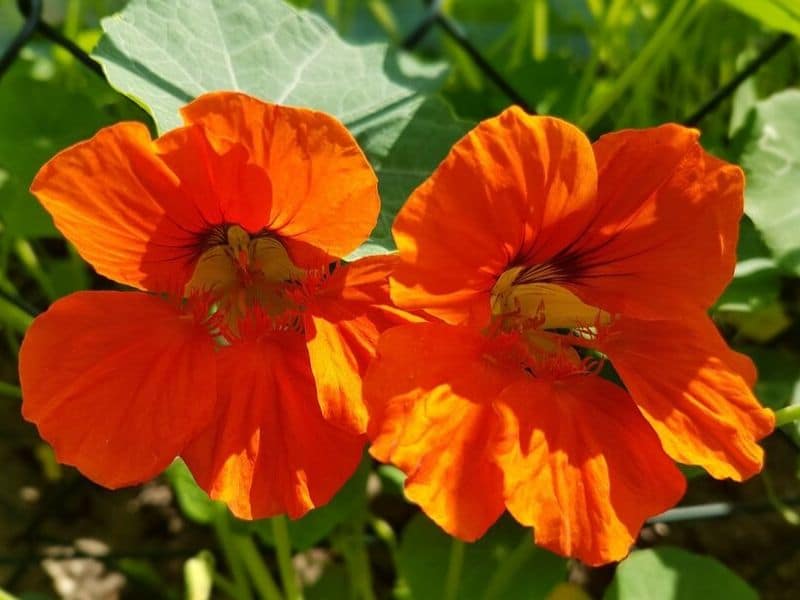
In general, most of the nasturtiums are having up to five petals, which makes the bushy plant perfect for garden backgrounds with its rich greeny mass and strong colourful blossoms (3).
The blooming period varies across different regions but is generally limited to summer months or the hottest in the year round. It blooms for 2 to 3 months if being properly cared for. The size of the flowers is between 2.5 and 6 cm in diameter (3).
How to grow Nasturtiums
Nasturtiums are not appropriate for indoor growing as they need an airy environment and a lot of sun.
If you want to plant nasturtiums blooming in early summer, you must grow the seeds in the early spring. Make sure you grow nasturtium plants in a very sunny place, as they need heavy sunlight to bloom more and longer, especially in warm climates.
Growing nasturtiums in well-drained and moist soil is ideal. If you plant them directly in the vegetable garden, nasturtiums do not need fertilizers as their roots do not require rich-ingredients soil (8). Just remember, robust soil properties can cause nasturtiums to put out more foliage and fewer flowers, so a good balance is important
Nasturtium seeds should be planted close to the surface (approximately 1.5 to 2 cm deep) and on approximately 25 to 30 cm distance from each other. One and a half weeks after planting, the flowers are likely to grow and appear above ground (8).
Care for nasturtium plants differs depending on whether they are grown in a sunny garden or peat pots. If you have nasturtiums planted directly in the garden, you can water them regularly during the growing season to ensure that roots have developed well and the nasturtium plants are healthy.
If you have nasturtiums in a pot, you have to water them when the soil gets drier in order to prevent rotten of the roots (or make sure the pot has good draining). In order to support growth and mitigate the limitations of planting the flower in a pot, it is a good idea to trim it while it grows before the blooming season.
Regardless of whether nasturtiums are planted directly in the garden or in a pot, removing dead flowers and any yellowing nasturtium leaves is likely to increase their blooming period (7). This will help the plant focus its energy on producing vibrant flowers instead of maintaining parts that are no longer functioning well.
Keep in mind that, when being taken care well, nasturtium flowers grow very fast and are climbing and thus, they might invade other plants in your garden.
At the end of the blooming season, you can collect the plant seeds of the nasturtium, clean them (without water), let them dry and then store them in a cool, dark and dry place, preferably in a paper pack (9).
Did you know?
Nasturtium has been one of the favourite flowers of Thomas Jefferson, who had it in his garden in all of its color variations.
Nowadays, nasturtium is one of the favourite garnish ingredients of Gordon Ramsay for some of his most popular dishes like Steak Tartare and Beef brisket.
Nasturtium is also used in experiments and anticancer activity research as it is believed it contains anticancer compounds (4).
FAQs
Do nasturtiums need direct sunlight?
Yes, nasturtiums prefer full sun to partial shade. They thrive in locations with at least 6 hours of direct sunlight per day.
How do you care for nasturtiums in pots?
To care for nasturtiums in pots, use well-draining soil and ensure adequate sunlight. Water them regularly, allowing the soil to dry slightly between waterings. Avoid overfertilizing, as it can promote variegated foliage growth at the expense of flowers.
Why is my nasturtium dying?
Nasturtiums may decline due to various reasons, including overwatering, underwatering, poor soil drainage, pests, diseases, or environmental stress. Assess the plant’s growing conditions and adjust care accordingly to address the issue.
How long do nasturtiums last?
Nasturtiums are annual plants, meaning they complete their life cycle within one growing season. However, they can reseed themselves, allowing them to return in subsequent years if conditions are suitable.
Can you overwater nasturtiums?
Yes, overwatering can be detrimental to nasturtiums, leading to root rot and other problems. Allow the soil to dry slightly between waterings, and avoid waterlogging the roots. Provide water only when the top inch of soil feels dry to the touch.
Final thoughts
In conclusion, mastering the care of nasturtium flowers brings the joy of vibrant blooms and lush foliage to gardens and outdoor spaces alike.
These versatile and easy-to-grow flowers reward care and attention with a profusion of colorful blooms and edible leaves, adding beauty and flavor to salads and culinary creations.
With the tips provided here, you’re equipped to create a beautiful garden oasis where you can enjoy the delightful charm of nasturtium flowers year after year.
Up Next:
References
(1) Garzon, G., Wrolstad, R. (2009) Major Anthocyanins and Antioxidant Activity of Nasturtium Flowers (Tropaeolum Majus). Food Chemistry. Vol. 114 (1), pp. 44-49. Source
(2) Mitra, A. (2019) Nasturtium (Tropaeolum majus) – an Annual Herb Has Medicinal Property to Cure Throat Sore and it Has Antivirus Property. Journal of Agricultural Science. Vol. 3 (1), pp. 1-3. Source
(3) Munir, M., Alhajhoj, M., Khakwani, A., Baloch, J. (2015) Flowering Time Response of Nasturtium (T\ropaeolum Majus L) Cultivar. Songklanakarin Science of Science and Technology. Vol. 37 (3), pp. 247-254. Source
(4) Yalcinkaya, E., Ozguc, S., Torer, Y., Zeybek, U. (2015) The Importance of the Medicinal Plant Nasturtium Officinale L. In the Anticancer Activity Research. Journal of Scientific Perspectives. Vol. 3 (2), pp. 159-164.
(5) Eyster, W., Burpee, D. (1936) Inheritance of Doubleness in the Flowers of the Nasturtium. Journal of Heredity. Vol. 27 (2), pp. 51-60.
(6) Sutherland, M. (1944) Vitamin C in Plants: “Nasturtium”. [online] source.
(7) Melo, E., Santos, O. (2011) Growth and Production of Nasturtium Flowers in Three Hydroponic Solutions. Horticultura Brasiliera. Vol. 29 (4).
(8) Albermani, S., Albermani, A., Altamene, H. (2017) Systematic Study of the Genus Nasturtium R. Br (Brassicaceae) in Iraq. Journal of Chemical and Pharmaceutical Sciences. Vol. 10 (1), pp. 352-358.
(9) Cruz, R., Vieira, M., Silva, C. (2010) Effect of Heat and Thermosonication Treatments on Watercress (Nasturtium Officinale) Vitamin C Degradation Kinetics. [online] source
Close
Photo credit: angelstar&monikasmigielska&Lohrelei/pixabay.com

